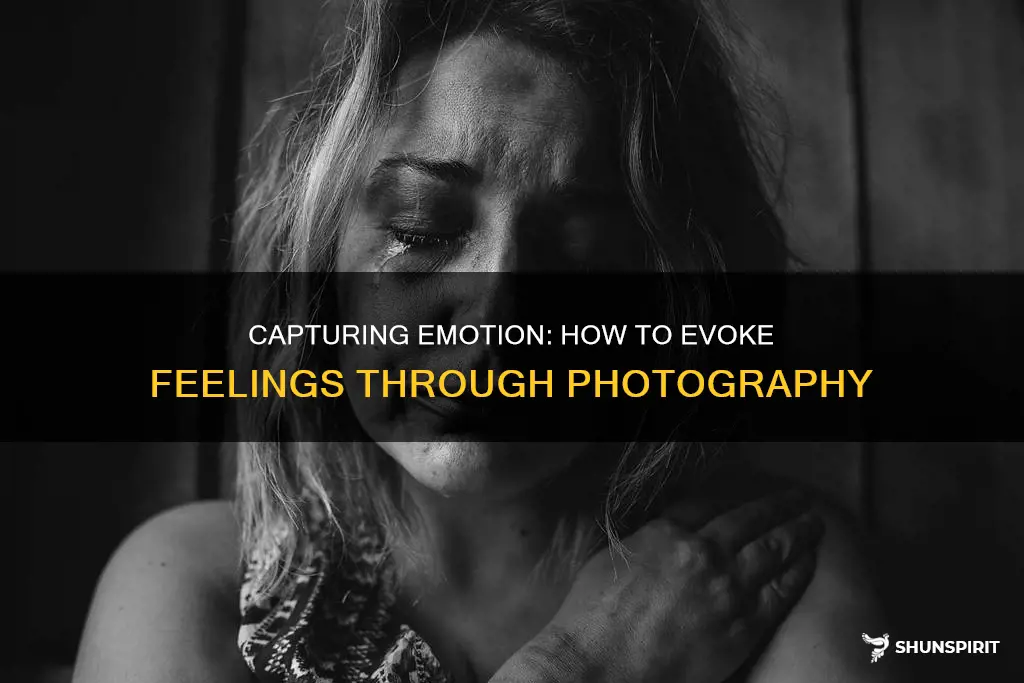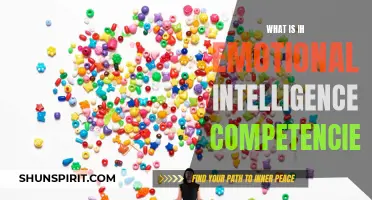
Photography is not just about capturing the perfect composition or getting the lighting just right; it's about capturing a moment and evoking emotions. The ability to show emotion through photography is a powerful skill that can transport viewers into another world, making them feel a sense of joy, sadness, wonder, or any other emotion the photographer intends to convey. It's an art form that goes beyond technical expertise and delves into the realm of human connection. In this guide, we will explore various techniques and tips to help you successfully show emotion in your photography, allowing you to create images that truly touch the hearts and souls of those who view them. So grab your camera, and let's embark on a journey to capture the emotions that make life worth living.
| Characteristics | Values |
|---|---|
| Composition | Rule of Thirds, Leading Lines, Framing |
| Lighting | Natural Light, Soft Light, Golden Hour Light |
| Color | Warm Colors, Cool Colors, Complementary Colors |
| Subject | Facial Expressions, Body Language, Gestures |
| Mood | Joy, Sadness, Anger, Surprise |
| Depth | Shallow Depth of Field, Deep Depth of Field |
| Perspective | High Angle, Low Angle, Eye Level |
| Timing | Capturing the Decisive Moment, Freezing Motion, Motion Blur |
| Atmosphere | Intimate, Energetic, Serene |
| Contrast | Light and Dark, Texture and Smoothness, Old and New |
What You'll Learn

Importance of Showing Emotion in Photography
Capturing the Essence: Photographs that evoke emotions have a lasting impact
Photography is a powerful medium that allows us to freeze moments and convey emotions. When looking at a photograph, we often connect with the subject portrayed and experience a surge of different feelings. This ability to evoke emotions is what sets apart extraordinary photographs from ordinary ones.
The essence of a photograph lies in its ability to capture the raw emotions present in a particular moment. Whether it is the joy and laughter of a wedding couple, the awe and wonder of a majestic landscape, or the intense concentration of a performer in action, a photograph that successfully conveys these emotions can have a lasting impact on the viewer.
To capture the essence and evoke emotions in your photographs, it is essential to pay attention to the details. Take time to observe your subject and understand the emotions they are experiencing. Consider their body language, facial expressions, and the environment they are in. By being present in the moment and truly connecting with your subject, you can bring out their authentic emotions in your photographs.
In addition to understanding your subject, it is crucial to have a strong technical foundation. Experiment with different camera settings, angles, and lighting to create the desired mood and atmosphere. Utilize composition techniques such as leading lines, framing, and rule of thirds to guide the viewer's eyes towards the emotions you want to convey.
Remember that timing is everything in photography. Anticipate the moments that will elicit strong emotions and be patient in waiting for them to happen. Whether it is capturing a smile, a tear, or a burst of laughter, being able to press the shutter at the perfect moment will make all the difference in creating emotionally impactful photographs.
Connecting with the Viewer: Emotional photographs engage and resonate with viewers
While capturing emotions in a photograph is essential, the ultimate goal is to connect with the viewer and evoke a response. Emotional photographs have the power to engage viewers on a deeper level, making them pause, reflect, and feel a sense of connection with the image.
To create photographs that resonate with viewers, it is crucial to consider the storytelling aspect. A photograph should tell a story and evoke emotions that viewers can relate to. Whether it is a photograph of a single person or a group of people, the composition, lighting, and overall mood of the image should be carefully orchestrated to convey a narrative.
Furthermore, it is vital to think about the context in which the photograph will be viewed. Different audiences may have varying interpretations and reactions to an image based on their background, culture, and personal experiences. By considering these factors, you can create photographs that have a universal appeal and are more likely to connect with a broader audience.
One powerful way to connect with viewers through emotional photographs is to focus on capturing candid moments. Candid photography allows you to capture genuine emotions and reactions without the subject being aware of the camera. This unguardedness creates a sense of authenticity that viewers can easily relate to.
Additionally, consider the post-processing of your photographs. The editing choices you make can greatly enhance or diminish the emotional impact of an image. Experiment with different editing techniques to bring out the desired emotions and create a cohesive visual style that resonates with viewers.
In conclusion, capturing the essence and evoking emotions in photography is essential for creating impactful and meaningful images. By paying attention to details, being present in the moment, and understanding your subject, you can capture authentic emotions that will leave a lasting impact. Additionally, by focusing on storytelling, connecting with the viewer, and considering the context in which the photograph will be viewed, you can create images that engage and resonate with a broader audience. Embrace the power of emotions in your photography and watch as your photographs create a profound connection between the viewer and the image.
The Surprising Truth About How Many Guys Show Their Emotions
You may want to see also

Techniques for Conveying Emotion in Photography
Photography is a powerful medium for capturing and conveying emotions. In order to create images that evoke a strong emotional response from the viewer, it is important to pay attention to various elements of photography, such as lighting, composition, timing, and more. In this blog post, we will focus on techniques for conveying emotion through photography, with a particular emphasis on lighting and shadows, dramatic lighting, different angles and intensities of light, composition and framing, emphasizing facial expressions and body language, incorporating meaningful backgrounds, timing and moment.
Lighting and Shadows:
Lighting plays a crucial role in conveying emotions in photography. By understanding how to effectively use light and shadows, you can create a mood that enhances the emotional impact of your images. Experiment with different types of lighting, such as natural light, artificial light, or a combination of both, to achieve the desired effect. Pay attention to the direction of the light and how it interacts with the subject and the surrounding environment. Shadows can add depth and contrast to your images, creating a sense of drama and intensity.
Using Dramatic Lighting to Enhance Mood:
Dramatic lighting can be a powerful tool for conveying emotions in photography. By using strong contrasts between light and dark areas, you can create a striking image that evokes a specific mood. Experiment with different lighting setups, such as side lighting, backlighting, or silhouettes, to create a dramatic effect. Play with the shadows and highlights to intensify the emotions you want to convey.
Experimenting with Different Angles and Intensities of Light:
Don't be afraid to explore different angles and intensities of light to capture the emotions you want to convey. Change your perspective and try shooting from different angles to create a unique and compelling image. Experiment with different light intensities and see how they affect the overall mood of your photographs. Remember, subtle changes in lighting can make a big difference in the emotional impact of your images.
Composition and Framing:
The composition and framing of your photographs can greatly enhance the emotional impact. Pay attention to the placement of your subject within the frame and consider using the rule of thirds or leading lines to create a sense of balance and harmony. Experiment with different compositions and framing techniques, such as close-ups or wide-angle shots, to create a specific mood or emotion.
Emphasizing Facial Expressions and Body Language:
Facial expressions and body language are powerful tools for conveying emotions in photography. Focus on capturing the subtlest of expressions and gestures that convey a particular emotion. Encourage your subjects to feel comfortable and relaxed, as this will help them express themselves authentically. Pay attention to the details, such as the wrinkles on the forehead or the tension in the hands, as they can reveal a lot about the subject's emotions.
Incorporating Meaningful Backgrounds to Add Depth and Context:
The background of your photographs can provide additional depth and context to your images. Consider incorporating meaningful backgrounds that complement and enhance the emotions you want to convey. For example, a serene natural landscape can evoke a sense of tranquility and peace, while an urban setting can convey a feeling of energy and urgency. Pay attention to the details in the background and how they interact with your subject to create a more compelling narrative.
Timing and Moment:
Timing is crucial when it comes to capturing raw and genuine emotions in photography. Be patient and observant, and wait for the perfect moment to click. Anticipate the emotions and reactions of your subjects, and be ready to capture that fleeting moment of true emotion. Remember, emotions are often best captured in spontaneous, unposed moments.
In conclusion, by paying attention to elements like lighting, composition, timing, and the emotional cues of your subjects, you can create photographs that convey powerful emotions. Experiment with different techniques and embrace the uniqueness of each situation. Photography is an art form that allows us to tap into the emotions and tell powerful stories through the lens. Embrace the challenge and enjoy the journey of capturing emotions through your photography.
How to Cultivate Emotional Intelligence in Your Child
You may want to see also

Enhancing Emotional Impact through Editing Techniques
When it comes to enhancing the emotional impact of your video, editing techniques play a crucial role. One of the most powerful ways to evoke emotions is through the careful choice of colors, as they have the ability to communicate feelings and set the overall tone of the footage. By adjusting color tones, utilizing color grading techniques, and manipulating contrast and saturation levels, you can elicit specific emotions in your audience and create a more impactful video.
Color choices are essential in determining the mood of your video. Each color has its own psychological associations, and by understanding these associations, you can make informed decisions about which colors to include in your footage. Warm colors like red, orange, and yellow tend to evoke feelings of warmth, energy, and excitement, while cool colors like blue, green, and purple often convey calmness, serenity, and relaxation. By incorporating these colors into your scenes, you can enhance the emotional impact of your video.
Adjusting color tones is another effective way to evoke certain emotions. By manipulating the color balance, temperature, and tint of your footage, you can create a specific atmosphere and evoke the desired emotional response. For example, adding a warm or orange tint to a scene can create a sense of nostalgia or intimacy, while adding a cool or blue tint can evoke feelings of isolation or sadness. Experimenting with different color tones can help you achieve the desired emotional impact for each scene.
Color grading is an advanced editing technique that adds depth and intensity to your footage. It involves manipulating color and exposure levels to create a desired aesthetic. By utilizing color grading tools, you can enhance the emotional impact of your video. For example, increasing the contrast and saturation levels can make a scene more visually striking and intense, evoking feelings of excitement or anticipation. On the other hand, decreasing these levels can create a softer and more subdued look, evoking a sense of tranquility or melancholy.
Contrast and saturation are two important elements to consider when editing your footage. Enhancing contrast can create a more impactful image by increasing visual separation between different elements in the frame. This can be achieved by adjusting the brightness, contrast, and levels of your footage. By making the subject stand out more, you can draw the viewer's attention and evoke stronger emotional responses.
Adjusting saturation levels is another effective way to evoke specific moods. Saturation refers to the intensity or richness of colors in your footage. By increasing saturation levels, you can make your video more vibrant and lively, evoking feelings of happiness or excitement. Conversely, decreasing saturation levels can create a desaturated or muted look, evoking feelings of sadness or nostalgia. Experimenting with different saturation levels can help you create the desired emotional impact for each scene.
In conclusion, enhancing the emotional impact of your video through editing techniques is a powerful way to engage your audience and convey your desired message. By carefully choosing colors, adjusting color tones, utilizing color grading techniques, and manipulating contrast and saturation levels, you can create a more impactful video that evokes specific emotions. Experimentation and creativity are key when it comes to enhancing emotional impact through editing, so don't be afraid to try new techniques and push the boundaries of your creativity.
Recognizing the Silent Suffering: How Emotional Abuse Takes a Toll on Elderly Individuals
You may want to see also

Storytelling and Narrative in Emotional Photography
When it comes to capturing emotions in photography, storytelling and narrative play a crucial role. By incorporating context and setting, utilizing elements within the shot, and focusing on the subject’s emotions and expressions, you can create powerful and emotive images. In this article, we will explore different techniques and ideas to enhance storytelling in emotional photography.
Context and Setting:
The context and setting of a photograph provide important visual cues to the viewers, allowing them to understand the narrative behind the image. Whether it's a moody and atmospheric location or a specific time of day, these elements can add depth and meaning to the photograph. For example, a desolate beach at sunset can evoke feelings of loneliness and contemplation, while an urban cityscape can imply a sense of hustle and bustle.
Using elements within the shot to tell a deeper story:
Incorporating objects or elements within the frame can help tell a deeper story. For instance, placing a worn-out suitcase in a portrait can imply a journey or evoke nostalgia. Think about the subject's surroundings and how they can be used to enhance the narrative of the photograph. It could be a favorite book, a personal belonging, or a piece of artwork that holds significance to the subject.
Incorporating surroundings to establish a narrative:
The surroundings of the subject can also establish a narrative in emotional photography. By choosing locations that reflect the emotions you want to convey, you can amplify the overall mood of the image. For instance, a gloomy forest can infer a sense of sadness or mystery, while a vibrant and colorful location can communicate happiness or excitement. Pay attention to the details and textures of the surroundings to further enhance the narrative.
Expressive portraits:
Portraits are a powerful tool in emotional photography as they allow us to capture a person's emotions and expressions. When capturing a portrait, focus on the subject's eyes and facial expressions. The eyes are often referred to as the window to the soul, and they can reveal a person's emotions in a powerful and authentic way. Encourage the subject to express themselves and capture candid moments to create a connection between the viewer and the subject.
Focusing on the subject's emotions and expressions:
Photography is all about capturing moments, and in emotional photography, the subject's emotions and expressions become the main focus. Instead of relying on posed shots, look for unguarded moments that showcase genuine emotions. This could be a subtle smile, a thoughtful gaze, or a teary-eyed expression. These authentic and raw moments will create a deeper connection with the viewers and evoke empathy and understanding.
Utilizing props and poses to enhance the storytelling aspect:
Props and poses can be used to enhance the storytelling aspect in emotional photography. Choosing props that hold meaning or convey a message can add depth to the image. For example, holding a wilted flower can symbolize loss or fragility. Additionally, posing the subject in a certain way can convey emotions or mimic a narrative. Experiment with different props and poses to find what works best for the emotions you want to capture.
Overall, storytelling and narrative are essential elements in emotional photography. By considering the context and setting, incorporating elements within the shot, focusing on the subject's emotions and expressions, and utilizing props and poses effectively, you can create powerful and evocative images that tell a story. Keep experimenting with different techniques and ideas to capture emotions in your photography and evoke a deeper connection with your viewers.
Signs That Indicate Whether Your Ex Is Emotionally Abusive
You may want to see also







